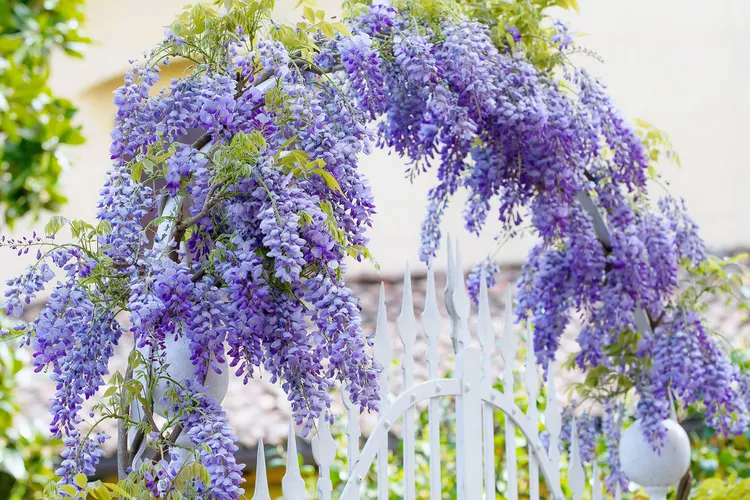Wisteria is absolutely stunning when in bloom, as anyone who’s watched the hit Netflix show Bridgerton may have noticed (it’s that gorgeous purple-flowered vine on the exterior of the Bridgerton family mansion). Wisterias look especially at home in cottage gardens, English-style gardens, or really anywhere their curtains of purplish, sweetly scented spring flowers can drape gracefully over an arbor or another strong support structure.
But before you add one to your own yard, you need to know that not all wisterias are created equal. Some of them are overly rambunctious, and can quickly take over your garden. Native wisteria species aren’t as aggressive or as large, but they’re just as gorgeous. Here’s how to select the best wisteria variety for your landscape.
Best Wisteria to Grow
The name to look for on plant tags is Wisteria frutescens, commonly called American wisteria. This species is native to the southeastern U.S., and it’s hardy in Zones 5-9, meaning it’ll grow in most areas of the country. American wisteria vines can reach dazzling heights of up to 30 feet. They act like a combination of a shrub and a vine, growing thick, woody stems over time that can wind around fences and, if given a trellis, scramble up the sides of a house. (Fun fact: this vine always grows counterclockwise when twining around a support.) Look for the widely available variety, ‘Amethyst Falls’, which produces huge clusters of flowers in May and often reblooms later in summer.
Another native to try is the (Wisteria macrostachya) or Kentucky wisteria. It’s the best choice for Northern gardeners, because it’s a little more hardy than American wisteria, withstanding winters as far as Zone 3. It can grow up to 25 feet tall, and begins blooming in June. The ‘Blue Moon’ variety has fragrant, bluish-purple flower clusters that can reach a foot in length. Once this vine is mature (usually after two or three years of growth), it can bloom up to three times in one season.
Besides having less aggressive growth, native wisteria varieties tend to mature and bloom sooner than the nonnative species, which can sometimes take a few years to flower after planting.
Invasive Wisteria Species to Avoid
When you’re shopping for plants, steer clear of Wisteria sinensis and Wisteria floribunda; they’re native to China and Japan, respectively, and while they’re pretty, both are invasive in several areas of the U.S. They can shoot up 10 feet in a single year, and can quickly reach up to 70 feet; if you don’t want them taking over, you’ll be stuck doing a lot of pruning. When they’re left unchecked, they can completely twine around shrubs and trees, blocking their sunlight and eventually killing them.
Those long vines are also heavy, to the point where they’ve been known to collapse fences and arbors under their weight. Once they’re established, it’s very difficult to get rid of non-native wisterias because of their tough root system. It usually takes repeated treatments with herbicides and continuous cutting down the vines to finally kill them, so it’s a lot easier to just avoid them completely if you can.
How to Grow Native Wisteria
Give your American wisteria a spot with well-drained, moist soil and full sun (where the plant will get at least six hours of direct sunlight every day). They can take some shade, too, but if you want to see hundreds of flowers every spring, full sun is the way to go.
Do your planting in the spring or fall. You’ll need to dig a hole that’s as deep as the root ball in its nursery container, and two to three times as wide. If you’re trying to create your own wisteria tunnel using multiple plants, space them at least 10 to 15 feet apart, so each one has plenty of room for its roots to develop. Once you’ve filled in the hole, water well to help the soil settle around the plants, and add a layer of mulch to hold in moisture and prevent weeds.
Wisterias are drought-tolerant once they’ve settled in, but you might still need to water them once a week if you don’t get at least an inch of rain. And for the best blooms, be sure to prune your plant every year in late winter. Wisterias flower on new growth and pruning encourages more stems to sprout on the plant. You can also prune the plant back in late summer if you’re trying to maintain a certain shape or height.
The right wisteria vines can be a beautiful addition to your landscape, but the wrong ones will quickly become problematic weeds. Pay close attention to the plant tags, and look for varieties of the native species. They’ll add gorgeous flowers to your yard without becoming a nuisance.




















